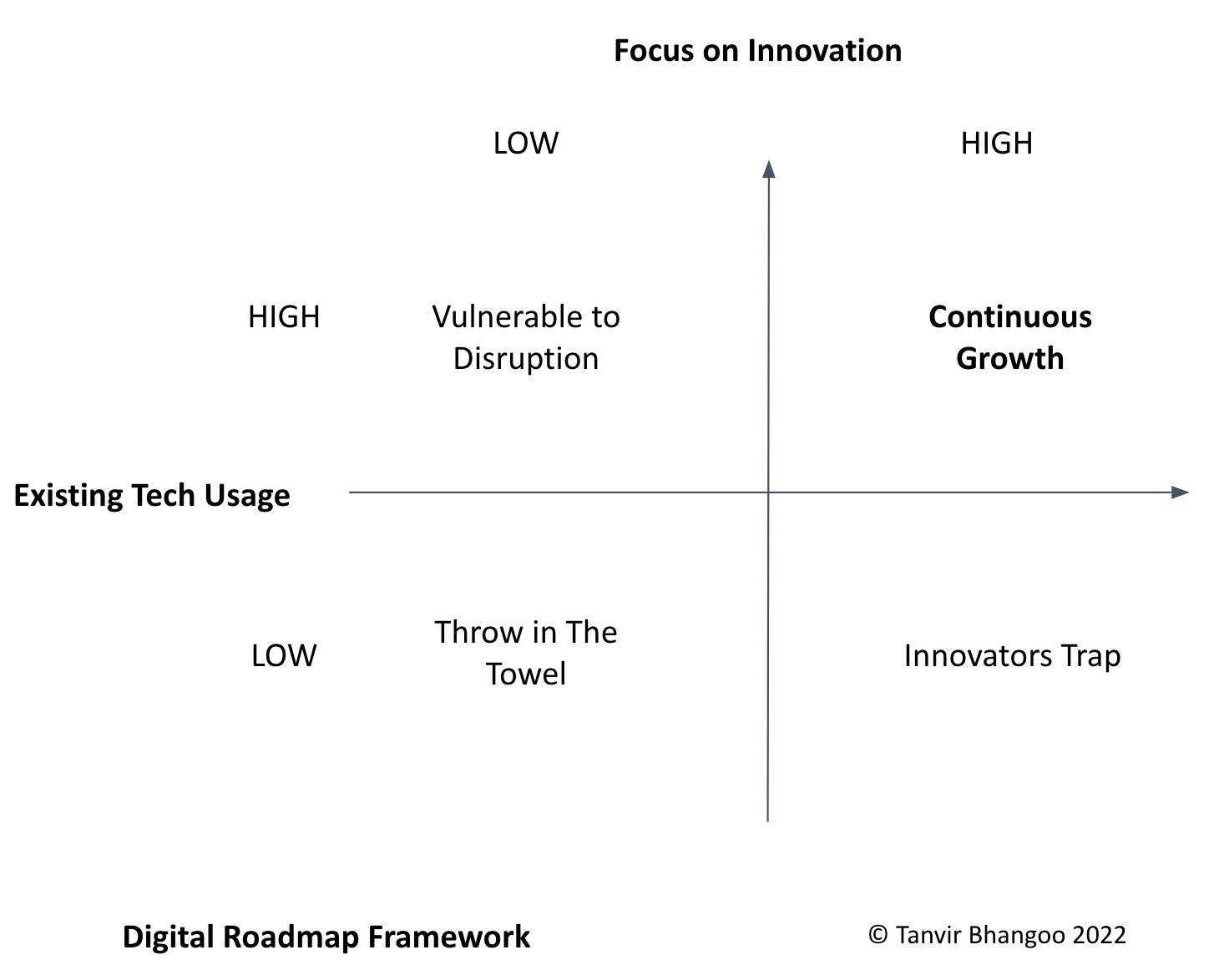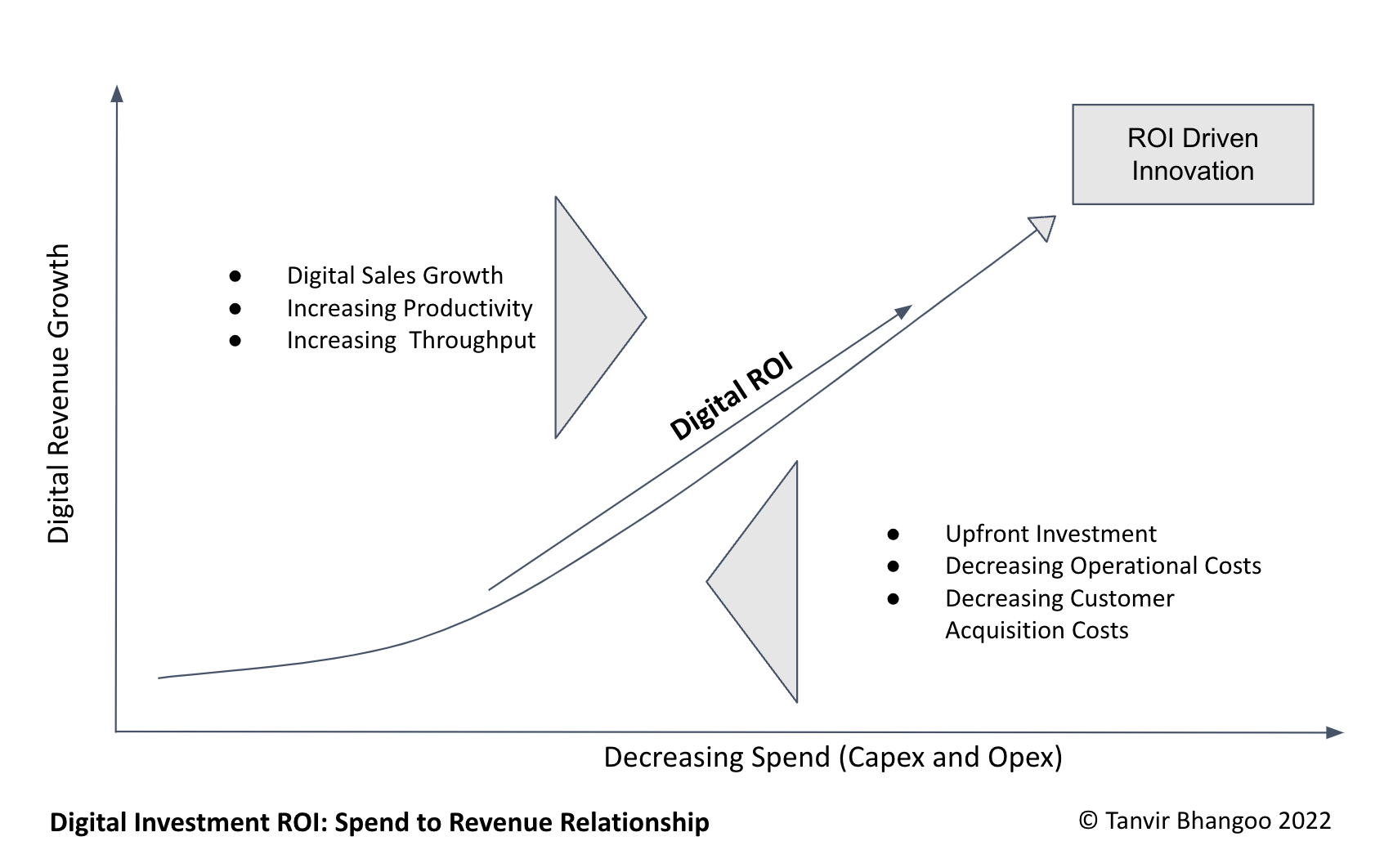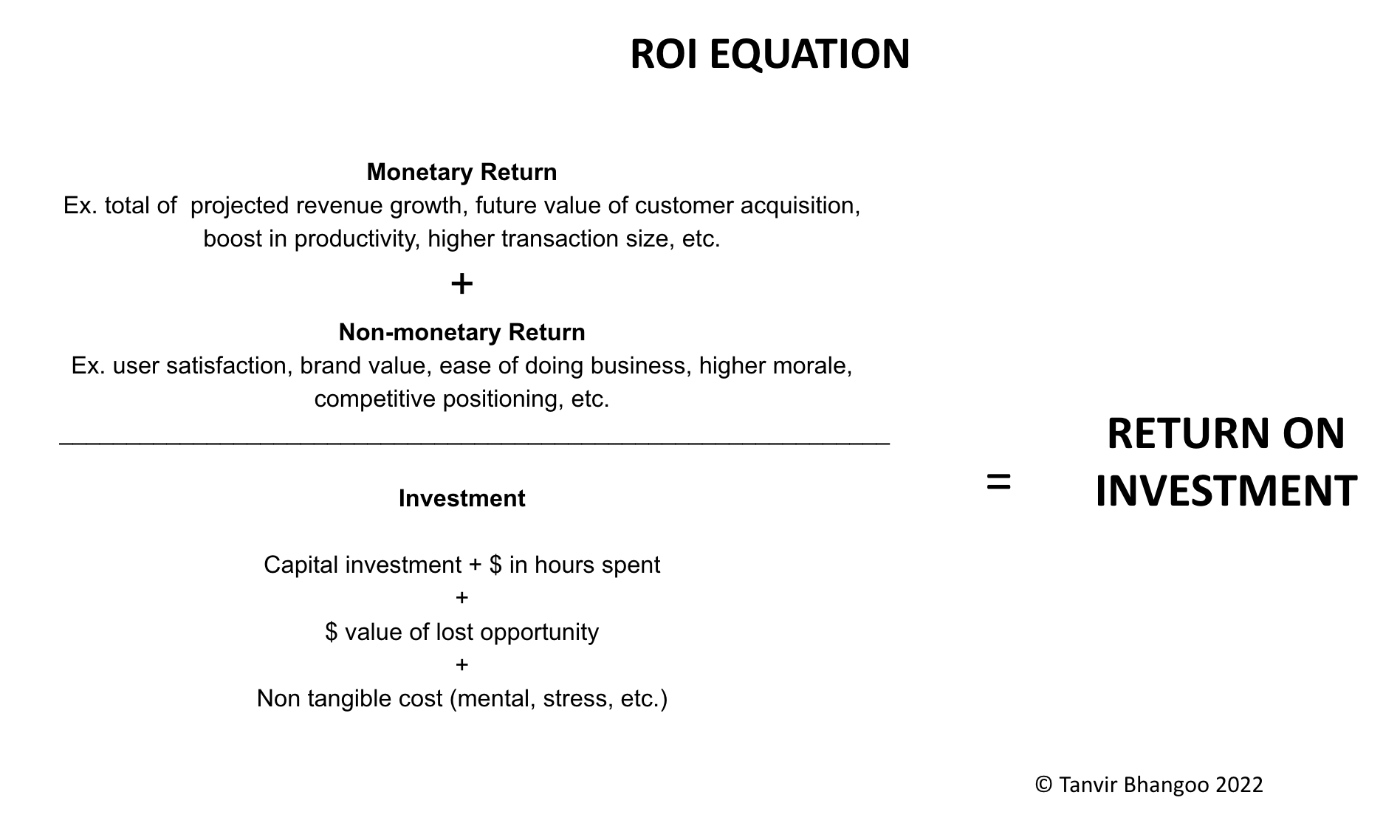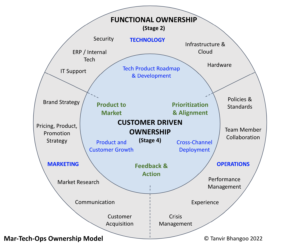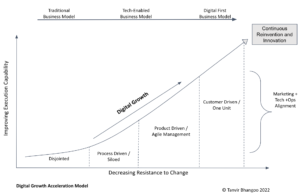I often see leadership teams focus on two extremes when it comes to their digital strategy and roadmap.
1- They go all in on new apps and step-change bets; things that are sexy and customer facing, but forget about the foundational elements.
Or
2 – Technology is treated as a cost center, and most of the effort/investments are placed on existing tech, fitting it to solve for new issues while quadrupling manual processes disjointed data flow.
The perfect balance is somewhere in the middle – think of it as a see-saw that needs to be well balanced on both ends.
In this week’s newsletter, I’ll share how to build a digital roadmap that balances legacy tech with innovation, how you can prioritize and define the ROI on key initiatives, and steps to implementing your roadmap.
Let’s first (re) define what a digital roadmap is:
A digital roadmap is your strategic plan where you lay out the technologies that you will be investing in, how these technologies will connect with different areas of the business, the milestones you plan to achieve along the way, and what key actions you will take as a business to hit these milestones. I won’t be diving into how to break down your roadmap to milestones and actions, but instead on high level roadmap and capability. (I discuss the formula for milestones and action plans in my latest book, which you can find here).
How are your digital roadmap and business strategy connected?
In short – your digital roadmap should be a subset of your business strategic plan. Digital roadmap is a strategic element that helps your business achieve its strategic goals. Hence, every part of the digital roadmap should tie back to achieving your overall business objectives.
And this is what many organizations miss. Here are a few symptoms of digital roadmaps not aligning with overall business objectives
- You invest in a brand new app and web platform, but your digital sales have not improved
- You experience bottlenecks when it comes to scaling (ex. POS cannot handle the multiple pricing regions as per growth)
- Your team is constantly fixing the wrong things (ex. an app that is working fine when the real issue is the POS integration at the store)
- Your team is constantly fighting fires (ex. Unstable systems and issues post launch)
- You hire a team of talented engineers and tech talent, but don’t see any uptick in digital growth
- Your digital team is working on industry defining ‘visionary’ products, and not so much on your current issues
- Your marketing and ops teams are always fighting with the tech priorities defined by your digital team
The Digital Roadmap Success Model: Formula for Innovation
As a mismatch between business and tech, most roadmaps skew towards one of the following focuses:
- Your tech roadmap only takes into account your immediate needs.
- You believe to win you must invest in game changing technologies, so you hire a team of engineers to redefine your industry
The goal is to find the balance between these two extremes. The diagram below illustrates the four potential outcomes when building a digital strategy and roadmap.
In this model, a digital roadmap feasibility is measured across two variables: (1) how well your business is making use of its existing (legacy) technology, and (2) how well are you tackling the needs of future innovation.
Let’s take a look at the four quadrants.
Throw in the Towel (low on both fronts):
When you’re neither focused on current technology, nor innovation – this is called “throwing in the towel. Companies here are at the mercy of the tech and systems that were once implemented, and no one really knows what most of the systems do. Hence, workarounds and manual processes become the norm. On the innovation front, there is little to no budget for a digital roadmap, and tech is seen as a cont center.
Unfortunately, there are a handful of companies that we hear about in the news that fall into this category, and many are finding it hard to stay competitive despite their large grasps on the market.
Vulnerable to Disruption (high existing tech usage, low focus on innovation):
In this category, a company has decided to make good use of its existing technologies, systems, and processes. At one point in time, a decision was made to invest in technologies from the standpoint of productivity and competitive pressures, but tech is still seen as a cost center. There is no focus on innovation except for the bare minimum, which leaves these companies vulnerable to disruption. Companies that recognize that what worked for them in the past will not work in the future, can be seen investing in new “digital labs” or acquisitions to become tech first, which ends up becoming a sprint without a solid foundation.
Innovators Trap (low existing tech usage, high focus on innovation):
Here you see a business solely focused on innovation, usually in a turnaround attempt. This happens most often after a change in leadership, acquisition, or new funding. I call this the innovators trap, because leaders in this stage tend to forget that there is a business that needs to be protected and managed, and that the innovation must align to the overall objectives with a vision for scalability. For example, there will be a new team working on brand new customer facing products, while no one manages the existing products or in store technologies. This causes real time issues at the customer level (broken websites, order pickup issues, etc.) and brand value takes a hit.
This also leaves a company vulnerable to the ever changing (and accelerating) tech-stack landscape. When companies are only focused on innovation and the next big thing, it often correlates to continuous integrations, swap outs, and migrations of new technologies every 1-2 years. Hence, this is why it’s vital to take the time and build a strong strategic outlook that is aligned to innovation, versus chasing the next best thing.
Continuous Growth (high on both fronts):
In this stage, you have a business that is maximizing the usage of its existing tech and systems, while being focused on building, deploying, and scaling new digital platforms. This is the perfect, yet delicate, balance when it comes to digitizing and transforming a business and shifting to a digital first business model.
Teams in this quadrant understand that it’s not always worth chasing the newest shiny tech toy, but make bold and well educated commitments to step change innovation for the long term. They also understand that the key during migration from current tech and systems to new foundations is driven by minimal impact to the customer, and hence invest in communication, support, and contingency planning as part of the transition. Ultimately, they are driven by the best course of action for the customers, and also tend to operate in a unified marketing-tech-ops function (something I discuss at length in my recent blog here).
Building a digital strategy and roadmap:
How do we build the strategy and roadmap that enables us to find continuous growth, based on the model above?
Here is a four step strategy phase to building a digital strategy and roadmap for higher chances of success, which includes capability analysis, criteria and evaluation, potential investments, and ROI and prioritization.
1. Do a capability analysis
We need to first understand our current state from a technology, digital infrastructure, and people capability standpoint. In other words, what are we dealing with today?
This starts with a clear understanding of the company’s strategic plan, its goals and objectives, and it’s competitive positioning. Identify where the business wants to go, and then assess whether or not it has the tools and capabilities in achieving those goals.
One of these strategic objectives should be to shift towards a digital-first business model (discussed in my digital growth acceleration model) – shifting revenues from traditional to digital first channels.
Once the objectives are clear, the next step is to assess the technology infrastructure, systems, integrations, partnerships, team and talent, execution and agility, and a few other areas depending on the business. Here are a few examples of potential gaps, to help you think:
For a global retail brand that is looking to expand operations in Europe, we may identify a gap in its customer facing app and loyalty program, in its ability to scale to multiple regions, support various languages, and integrate with different language and data management platforms. This may also translate to operational gaps at the store level given some of the technologies in Europe may not have ready to go integrations with the systems in use today.
Or, for a small 300 store coffee shop chain looking to improve its digital sales from 5% to 20% of total sales, we may find that the business lacks a robust marketing-technology infrastructure, ability to collect customer data, and a marketing automation tool set to shift consumer behaviors. It’s also likely that the business does not have the talent required to drive digital adoption from a digital marketing standpoint.
Or, you discover that marketing uses a customer data platform that doesn’t speak to the app or web, which is managed by “IT.” Marketing then requires the finance team to reconcile its customer data to sales data, which takes a few weeks of manual work. Once its reconciled, there are three different versions of total cost of acquisition given errors in reporting – and you’re not able to define the cost of customer acquisition clearly, which is a big requirement for further rounds of fundings.
All this happens while the tech team is launching new app features that are not speaking to the actual customer needs as per feedback from the field team.
At the end of the analysis, we should have a clear picture of what we have, what is missing, and how big the gap is, so that we can define what investments will be needed to bridge the gap.
2. Bridge the legacy and innovation chasm
Once we understand the current state, it’s important to build a rough roadmap that takes you from where you are today to where you want to go.
The most important part of this section is to start with the technologies and infrastructure that is already in place, and build a roadmap that (1) maximizes their usage, and (2) minimizes disruption as you modernize your technologies.
Another useful tool is to build an architecture diagram, which lays out all the technologies you have today, how they are connected, what new technologies and systems you will need to integrate, and how they will speak to each other. This helps identify which technologies can be leveraged today, which technology foundations can be built upon, and which must absolutely be migrated.
This approach will help illustrate the most important pieces of your current technologies, build a phased approach to migration, and help you uncover the how behind the future architecture that you have identified.
3. Shortlist options with focused criteria
Once you identify how current technology works and is integrated, and where you are looking to go, now it’s time to identify which new investments and technologies you need to make, by running these against a criteria based on the business and your goals.
Note: the point here is to build a wish list of technologies and systems you need to bridge your capability gaps. This stage does not include making tradeoffs or evaluating any technologies from an RFP perspective (yet).
The list of criteria will depend on the nature, stage, and size of the business. But there are a few elements that should be included when identifying your future state.
Business level criteria
- Meets business objectives
- Leverages existing resources
- Meets non-monetary constraints if any (i.e. short term contract)
- Operational impact to existing business (i.e. disruption)
- Operational benefit to existing business (i.e. throughput)
Customer level criteria
- Allows for a seamless guest experience
- Allows to shift and meet changing consumer demands
- Upholds customer data integrity and security
Technology criteria
- Ease of implementation
- Alignment to long term technology goals and architecture
- Ease of use for internal team
- Capability and integrations for future needs or changes
- Tech support by vendor team
- Tech security standards and certificates
- Tech vendor reputation and business continuity
This will help you lay out and assess your technology wish list options that are best aligned to your business, and make it easier to make key decisions. For example, if a major “no” for you is a vendor that does not have dedicated support, then that will eliminate some options that you or the team might have considered.
4. Calculate return on investment and prioritize
Finally, now its time to take your shortlist of systems and technologies, along with your existing tech stack, people, and processes, and build a digital roadmap with milestones.
One of the major components of a roadmap is the prioritization of these technologies against other initiatives, how much to spend, and timing of implementation. Hence, we need to calculate the Return on Investment on your digital roadmap.
Figure: ROI justification model
This model shows the relationship between spend and revenue or growth as part of your digital investments. The reality is that every roadmap requires an upfront investment, either at the corporate, store, or partner level. If done right, the return on investment will increase over time.
On the Y axis, you have digital revenue growth, which is the ultimate goal of a digital roadmap. It increases from bottom to the top.
On the X axis, you have digital spend, which starts off high in the beginning given capital investments, and then cuts down significantly.
The Digital ROI model argues that over time, your digital revenues increase, from a sales growth, productivity, and throughput standpoint as a result of your tech investments. Similarly, your marketing spend also decreases given the upfront investment was a one time cost, followed by decreasing operational costs, and lower cost of customer acquisition. Hence, as revenues increase, your costs decrease, increasing your return on investment over time.
I won’t be diving into the specifics of how to do an ROI analysis per each technology or system, and how to calculate the payback timeline (how long it takes to make your investment back via sales). But here is a simple framework for a rough estimation.
5. Operationalize digital roadmap
If you’ve been reading my blogs and newsletters, you know that strategy is half the battle, the other half, and the most important, is execution. Here are a few steps on operationalizing your digital strategy and roadmap.
This is where we put in place the systems and action plans to execute on the roadmap.
This should include
- Building a timeline with key milestones, resource allocation, tradeoffs and deliverables.This allows teams to stay on track, and keep their eyes on the prize, with clear division of accountabilities and decision making rulesets
- Building a rule set to stay away from shiny toys. Evaluate any new opportunities against this rule set so that you’re not continuously modifying your roadmap
- Maximize existing legacy technologies while roadmap implementation is underway. Most of the time, tools are disconnected. Invest time in finding quick wins across teams with what you have at your disposal today. You’ll be surprised at what you can accomplish instead of waiting
- Build performance management practices across teams. This should include objectives, metrics and how results are measured, and ongoing cadence to ensure everything is on track
Bio:
Tanvir Bhangoo is a consultant and advisor who works with C-level executives, helping them accelerate their digital growth and boost operational efficiencies. He’s also a bestselling author and a former tech executive. He’s a graduate from DeGroote School of Business MBA program, and also a collegiate football national champion.
Contact: you can reach him directly at tanvir@tbxdigital.com
“In what I now know is Tanvir’s signature style, Tanvir was able to rally the right people, align, focus and drive the project to completion without using fear or ego.” – Jeff Adamson, Cofounder, SkipTheDishes and Neo Financial
“In a world of digital disruption and where our minds never stop to rest, his stories and insights remind us of the basics (and not so basics) necessary to making big plays in business and in life.” – Kelly MacPherson, CTO, Union Square Hospitality Group

